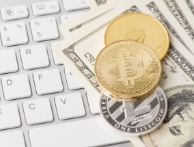What are Altcoins? A Brief Summary

Investors can access various digital assets through the cryptocurrency market, a sizable sector of the economy. In crypto, investors include cryptocurrencies, non-fungible tokens, exchange-traded funds, and other potential decentralization-related technologies.
However, this was only sometimes the case since the crypto market in 2009 was compromised just by Bitcoin, the premier cryptocurrency.
For investment possibilities, you can invest in all types of cryptocurrencies, including Ether, Dogecoin, Litecoin, XRP, and many others. Bitcoin-accepting cryptocurrencies are known as altcoins because they are distinct from Bitcoin in terms of their operations or characteristics.

What are Altcoins?
“Alternative Coins” refers to the cryptocurrencies known as “Altcoins.” As a result, altcoins are any currency that is not Bitcoin. Alternately, altcoins are digital assets that offer a substitute for established crypto solutions. As with Bitcoin, altcoins use the blockchain. A decentralised digital distributed ledger known as a blockchain serves as a secure database.
Each alternative cryptocurrency exceeds its connected coin in terms of transaction times, fees, and mining costs. Ethereum, Litecoin, Ripple, and many more cryptocurrencies are good examples. These tokens have traits and attributes. Alternative currencies are classified based on their uses and operations.
Types of Cryptocurrencies
There are various kinds of altcoins available, and they might differ from one another and bitcoin in terms of the features and operations they can do.
1. Security tokens:
A security token is a digital token that, like traditional private securities, symbolises the value of an underlying asset. It can stand in for stock in a corporation, a stake in a fund or trust, a house, a collection of works of art, a farm, or pretty much any item a person could hold.
2. Utility tokens:
Utility tokens are digital assets used to finance networks by giving purchasers the assurance of using some of the goods made available on those networks.
3. Cryptocurrencies:
If a token was designed to be used as payment for products or services not provided by the platform that issued it, it might be said that it is a currency. For instance, bitcoin is seen as a form of money because it was designed to displace fiat money. As a result, bitcoin owners may use their currency to pay for products and services from physical stores, internet retailers, and other vendors.
Popular Altcoins in the cryptocurrency market
1. Ethereum:
Ethereum is similar to Bitcoin, also called Blockchain, but has essential upgrades. It’s an innovative ecosystem in addition to a cryptocurrency. Ether is the Ethereum ecosystem’s currency. Just a little less than Bitcoin’s market capitalisation. To power any operation on the Ethereum blockchain, ‘gas’ is required. Decentralised apps (DApps), which are based on software known as “smart contracts,” are the main objective of the Ethereum Blockchain. Ethereum is a worldwide, open-source platform similar to an Android system for DApps, where developers may obtain all the tools and environments required to create a DApp.
2. LiteCoin:
Litecoin is an altcoin spinoff of Bitcoin. It’s a source-code clone of Bitcoin and is faster and cheaper. Ex-Google employee Charlie Lee created LiteCoin in 2011 and ranked second once. The similarity between Bitcoin and Litecoin made it an excellent testbed for bitcoin to develop new technology Atomic Swap, SegWit, Lightning Network, and MimbleWimble.
Scrypt is the mining algorithm used by Litecoin. To allow for a greater degree of decentralisation, it was initially designed to prevent ASIC miners from having a significant advantage. According to the crypto community, one of the earliest cryptocurrencies to emerge was Litecoin. Litecoin would be digital silver if Bitcoin were analogous to digital money.
3. XRP:
A globally distributed ledger database called XRP Ledger, created by Ripple, supports a payment and exchange network called RippleNet. Mining takes time and energy for both Bitcoin and Ethereum. Hence, XRP Ledger uses a unique consensus algorithm that doesn’t require that. The XRP Ledger’s consensus algorithm relies instead on validators. It depends on overlapping sets of “trusted validators” (called the “Unique Node List,” or UNL) that efficiently agree on the order of transactions in the network.
Its goal is to transform payment and remittance systems, especially SWIFT. The crypto community often refers to it as the ‘Banker’s Coin’ since it seeks to replace old payment systems in financial institutions.
4. EOS
EOS was created to address the problems with Ethereum with its free transactions, quicker transactions, and friendlier developer environment. A blockchain platform called EOSIO is adaptable to a wide range of business demands across sectors and is designed for both public and private use cases. Building on EOSIO adheres to the same well-known design principles and programming languages that current non-blockchain apps use.
5. Cronos
Among Crypto.org Chain’s native tokens, Cronos (CRO) is the most prominent. The Crypto.org Chain establishes a network of cryptocurrencies and businesses that accept cryptocurrencies. Users of cryptocurrency and companies that take it can carry out seamless, inexpensive, and secure transactions using the Crypto.org Chain.
Eligible individuals can use and earn CRO tokens in connection with this product in the following key ways:
- Settlement
- Stalking
- Payment
6. Stable Coins
Most countries prefer a regulated advantage over the use case of decentralisation that every cryptocurrency represents, resulting in stable currencies. Trading cryptocurrencies is risky due to their volatility, which is awful for end investors. On the other hand, stablecoins provide a quick fix by having their values tied to other assets like fiat money, precious metals, and even other cryptocurrencies.
Several methods are used to achieve the near-perfect peg:
- Dual coins
- Leveraged loans
- Algorithm coins
- Reserving pegged assets
Exploring the World of Altcoins
There are altcoins for many types of investors, with more being produced as you read this. It is the beauty of altcoins, whose current uncertainties are their almost endless potential. Scratching the surface is just the beginning. For those who want to delve deeper into the world of financial investments, including altcoins, be sure to conduct your research, make your decisions wisely, and remain aware that there are no financial guarantees.
Conclusion
Always choose a portfolio with diversification. Altcoins are the ideal choice if you are a cryptocurrency expert and want to get a “piece of the pie”, especially if you’re going to purchase assets for a fair price. To make a well-informed choice, investigate the coin and lock for a famous expert’s advice.
Posted Date: May 23, 2023




